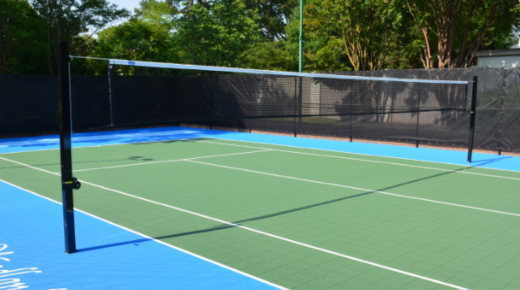Introduction
Volleyball is one of the most energetic and fast-paced sports, requiring a high-performance court that ensures player safety, durability, and long-term playability. Whether you’re constructing a volleyball court flooring for a school, club, or public sports complex, the foundation of excellence lies in choosing the right sports court flooring. And when it comes to quality, resilience, and all-weather suitability, acrylic flooring materials are the clear winner.
In this blog, we’ll guide you through the essentials of volleyball court construction, focusing on why acrylic sports flooring is ideal, how it compares with other surfaces like basketball court flooring, and what makes it the go-to choice for indoor and outdoor volleyball courts.
Why Flooring Matters in Volleyball Courts
A volleyball court isn’t just about the net and boundary lines—it’s about delivering a surface that:
- Minimizes injury risk
- Provides excellent grip and bounce
- Withstands intensive daily use
- Is suitable for both indoor and outdoor environments
This is where acrylic flooring materials come into play. Already trusted for basketball court flooring and multi-sport facilities, acrylic offers a versatile, professional-grade solution for volleyball as well.
What is Acrylic Sports Court Flooring?
Acrylic sports court flooring is a synthetic, multi-layered system applied over a concrete base. It delivers a balance of cushioning, surface grip, and aesthetic finish, tailored for various sports.
Key Benefits for Volleyball Courts:
- Non-slip surface for improved player safety
- UV and weather resistance for outdoor use
- Customizable colors for professional appeal
- Low maintenance and long-lasting performance
- Consistent bounce and excellent ball control
Steps to Build a Volleyball Court with Acrylic Flooring
Here’s a simplified step-by-step guide to help you plan your volleyball court project:
Site Selection & Base Construction
- Choose a leveled, well-drained location.
- Ensure proper slope (approx. 1%) for water drainage.
Surface Preparation
- Clean and smooth the base.
- Apply a concrete primer for acrylic bonding.
Acrylic Resurfacer & Texture Coats
- Use a resurfacer to fill minor surface imperfections.
- Add texture coats for skid resistance and shock absorption.
Top Color Coats
- Apply 2–3 layers of high-quality acrylic flooring materials.
- Choose vibrant, fade-resistant colors for visual appeal.
Court Markings
- Add official volleyball lines using weather-resistant paint.
Volleyball vs Basketball Court Flooring: What’s the Difference?
Although basketball court flooring and volleyball courts both use acrylic systems, the texture, line markings, and shock absorption levels can vary based on the sport’s specific needs.
| Feature | Volleyball Court | Basketball Court |
| Surface Texture | Medium-grip | High-grip |
| Bounce Level | Medium | High |
| Cushion Coating | Optional | Often included |
| Court Size | 18×9 m (standard) | 28×15 m (standard) |
The flexibility of sports court flooring allows for customization based on sport-specific demands.
Where Can You Use Acrylic Flooring?
- Schools & Colleges
- Private Clubs & Resorts
- Multi-Sport Complexes
- Government & Community Parks
Because acrylic is part of a broader sports court flooring system, it can be adapted for volleyball court flooring, basketball court flooring, pickleball court flooring, tennis court flooring, and more—all on the same surface.
Conclusion
When planning to build a professional or recreational volleyball court, your flooring choice makes all the difference. By using high-quality acrylic flooring materials, you ensure a surface that meets international standards, boosts player performance, and requires minimal upkeep.
Whether you’re upgrading an old surface or building a brand-new court, acrylic flooring offers the perfect balance of performance, durability, and aesthetics.



